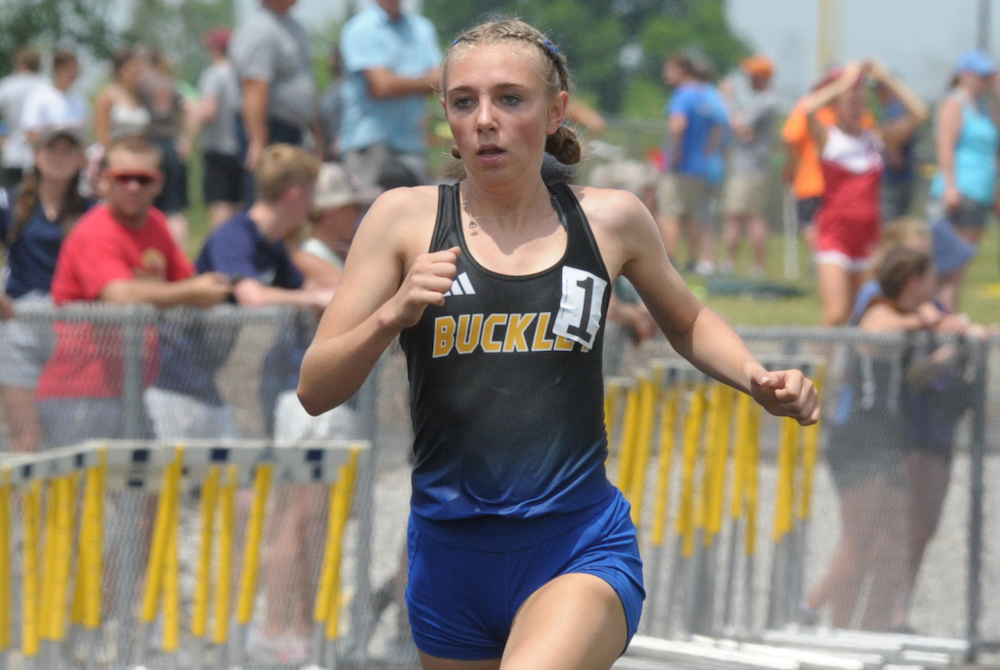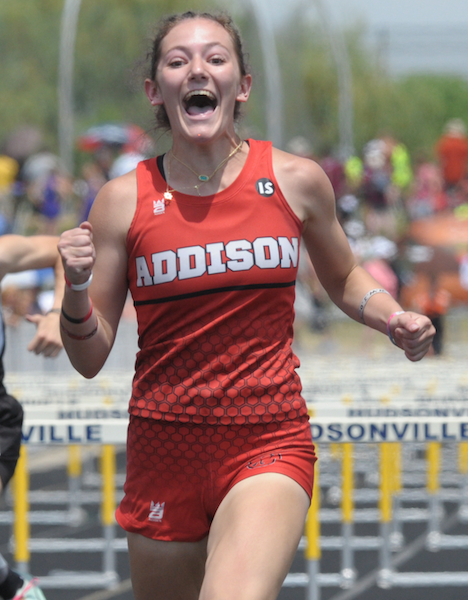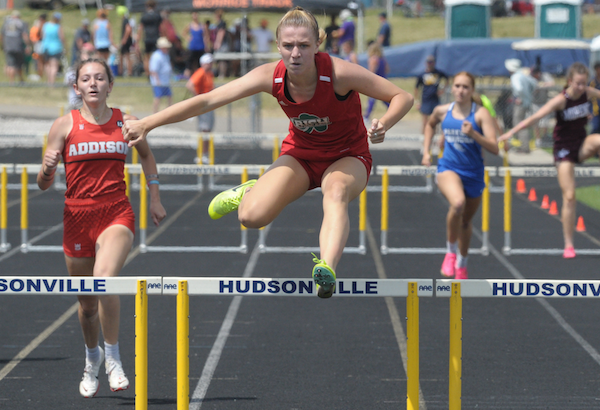
Track Gaining Speed Toward Future with Electronic Starting Devices
By
Steve Vedder
Special for MHSAA.com
May 23, 2023
Aubrey Greenfield thinks it might be the perfect time to reevaluate 130 years of tradition.
For a number of reasons, from technical to personal, the Oxford senior sprinter believes it makes sense for the crack of a starting pistol to be eliminated from high school track meets.
Because track meets would benefit in various ways from lowering costs to easier setup at meets to the human factor of competitors not having to flinch at the crack of a pistol shot, Greenfield believes the sport has a chance to embrace new technology – electronic starting devices (ESD).
In essence, an ESD replaces the starting pistol with a light flash, tone sound or both to begin a race.
"High school sports should put the athlete first," Greenfield said. "We should promote sports, and eliminating starting pistols promotes health in terms of PTSD or trauma for athletes and spectators and that would be good. I would like to think people would say that's a good idea."
In fact, Greenfield would go as far as to say if there was not an implementation of electronic starting devices, many of her teammates would have considered giving up the sport.
"If it's something that helps us compete safely, we're all for it," she said.
Greenfield's opinion apparently is spreading. Michigan High School Athletic Association senior assistant director Cody Inglis said the use of ESD makes it both affordable for meet starters and sensible for athletes and fans to rethink the use of starting pistols. While the MHSAA is not mandating electronic starting devices, it does promote the use of what Inglis calls "emerging technology." He notes that ESD are becoming the norm for organizations such as USA Track & Field, the NCAA and an increasing number of high schools.
 "I think we have to embrace new technology, and we think this will be something that takes hold," Inglis said.
"I think we have to embrace new technology, and we think this will be something that takes hold," Inglis said.
A key part of embracing ESD is the human element. The tragic Oxford High School shooting Nov. 30, 2021, that took the lives of four students while injuring seven others should not be relived even for a fleeting instance at a high school sporting event. Oxford athletic director Tony DeMare said the school began using ESD at every meet, including the MHSAA Lower Peninsula Division 1 Finals last June. He said that decision was embraced by virtually all schools Oxford encountered.
"We were very convinced that the alternative (of ESD) would promote a healthy attitude," DeMare said. "We were overwhelmed with the positive response. If a school was on the fence about it or might not be for it, I think we've started to see the tide turn in favor of people willing to listen and learn about electronic starting devices."
Inglis said the MHSAA is acutely aware of what the crack of a starting pistol can mean to athletes and fans.
"It's unimaginable what Oxford went through, and this is a small way we can help," he said. "We look at a (starting pistol) and think, ‘Could we do something else?’ It's a way of helping to solve a problem."
Over the last several years, the MHSAA has embraced finding an alternative to starting pistols. Inglis noted the discussion started with the cost and diminishing availability of 32-caliber ammunition that meet starters use. A box of ammunition, if it can be found, is around $75 a box.
In addition to cost, there is potential damage from excessive exposure to 150-plus decibels of sound generated by the traditional 32-caliber blanks. Medical studies show damage to ears caused by decibel levels above 120 dB.
The tragedy at Oxford accelerated the conversation.
Inglis said the cost of ESD can be likened to a school sinking money into artificial surfaces at football fields. Yes, there is a great cost at first, but over time money is ultimately saved. An ESD system itself ranges between $200 and $500. Speakers also may need to be purchased, but with ESD starting events like the 800 and 1,600-meter relays positioned near the outside lanes 8, 7, 6 and 5 would result in improved hearing by athletes at the start of a race.
There is one challenge with ESD that track administrators are working to overcome – lighting conditions that lessen the ability to see the ESD’s LED light or strobe when the button is pressed by a starter to begin a race. But that vision difficulty resulting from clear blue skies and backgrounds of setting suns can be substantially improved by incorporating a black background with an ESD – something as simple as a starter holding up black cardboard behind the lighting mechanism at the start of an event.
Inglis said when all factors are considered, the use of ESD makes sense.
 "With the climate we live in nowadays, no lookalike guns is good," he said. "We're not mandating this. But people are saying this is affordable."
"With the climate we live in nowadays, no lookalike guns is good," he said. "We're not mandating this. But people are saying this is affordable."
While switching to ESD would break 130 years of tradition, the timing could be a step forward, said Jeff Hollobaugh, co-author of the book "The Fleet Feet of Spring: Michigan's High School State Championships in Track & Field." He said while no definitive answer is possible, it's likely starting pistols were used at the inaugural state meet at the Jackson Fairgounds in 1895. The meet, which included events like tossing a 16-pound shot put, bike races and a 100-meter sprint, was sponsored by the Michigan Interscholastic Athletic Association (a predecessor to the MHSAA) and comprised mostly of the state's larger schools.
Hollobaugh's sentiments echo what many involved in today's high school track & field believe in terms of making a transition from starting pistols to electronic starting devices.
"It's a change, not necessarily good or bad, just different," he said. "It's not a drastic change, but it will take some getting used to. But it is the future. In the end, we'll all be fine."
DeMare believes the future of high school track will definitely include ESD.
"Our desire is that the practicality and sensibility of this will overcome the alternative," he said. "I think we'll see the automation and electronics taking hold of certain elements in track, and people will embrace it."
PHOTOS (Top) Runners watch official Bertha Smiley as they prepare to begin a race during last season's Lower Peninsula Division 1 Finals at Rockford. (Middle) An electronic starting device provided by VS Athletics was used to start those races. (Below) Smiley sets to begin an event. (Photos provided by David Kuderka/VS Athletics.)

Speedy Sprint-Distance Tandem Carries Buckley to 1st Championship
By
Tom Lang
Special for MHSAA.com
June 3, 2023
HUDSONVILLE – Buckley capitalized on the balance of junior distance star Aiden Harrand and freshman standout sprinter Brooklyn Fraeze to rack up the points needed to win the Lower Peninsula Division 4 track & field championship with 52 points Saturday at Hudsonville.
The team title was Buckley’s first in girls track & field.
Harrand won the 1,600 for the third-consecutive year and added titles in the 800 and the 3,200, leading her team to the championship. Those three wins followed her cross country Finals championship from the fall.
“I think it’s kind of fun,” she said about racking up the titles. “My team motivates me, I mean we’re in it as a group and my points matter, so I do it for them.
 “It was a cool experience to have, winning those two,” she said about the two longest races, the 1,600 and 3,200, which were the hardest of the overall meet due to the low 90s/high 80s heat and searing sun all day. Race officials allowed the unique opportunity for coaches to spray the runners with water and give them water bottles.
“It was a cool experience to have, winning those two,” she said about the two longest races, the 1,600 and 3,200, which were the hardest of the overall meet due to the low 90s/high 80s heat and searing sun all day. Race officials allowed the unique opportunity for coaches to spray the runners with water and give them water bottles.
“The water on the backstretch was so nice, and I’m really glad it was there,” Harrand said about the unusual experience. “My coaches were spraying me, and that was so nice to have.
“And our girls took first overall, so we’re really excited for that. Me and Brooklynn (Fraeze) had lots of points, and our 4 x 400 (eighth place) got us the last points we needed. It was amazing, and this is why we do it.”
Fraeze, a freshman, won 100 dash with a personal best of 12.47. She added a runner-up finish in the 200.
“I was like, oh my gosh I’m doing it, the finish line is right there,” she said about the last 10 meters of the 100, as she finished just ahead of Molly Brown of Addison (12.57).
Brown later won the 100 hurdles.
“The girl who got second place, I felt her at like the halfway point and I was telling myself ‘I’ve got to go,’” Brown said of the hurdles win. “And after I finished the race, I was thinking about it and I heard my family yelling for me. I saw my dad and I started crying; there’s just a lot of emotions.”
Her team finished sixth.
Portland St. Patrick was the team runner-up, just three points back at 49. Indian River Inland Lakes took third, Fowler was fourth and Hillsdale Academy took fifth.
Mount Pleasant Sacred Heart senior Anna Plum successfully defended her 300 hurdles title.
 “I think I was actually seeded third, but I had high expectations since I won last year and I really wanted that again,” Plum said. “It’s kind of like validation.
“I think I was actually seeded third, but I had high expectations since I won last year and I really wanted that again,” Plum said. “It’s kind of like validation.
“We put in great practices, and God, honestly,” she credited as factors for her win and the team’s focus. “We are Sacred Heart and believe in God and put a lot of trust in that.
“My feet are pretty hot right now,” Plum added about the weather conditions. “I bet I’ve got some pretty big blisters. I don’t even know how the 3,200 runners do it. It was insane today.”
Rylee Scheurer led St. Patrick by winning the 200 (25.82), and Natalie Wandrie keyed Inland Lakes’ pursuit with wins in the shot put (39-8) and discus (128-11). Frankfort in the 400 (50.68), Fowler in the 800 (1:47.17) and Hillsdale Academy in the 1,600 (4:08.08) and 3,200 (9:57.73) were relay champions, and Beal City’s Kaylee Locke won the 400 (58.55).
Marlette’s Olivia Findlay won the high jump (5-4) and Wyoming Potter’s House Christian’s Sohanny Gonzalez-Castillo won the long jump (17-4). Deckerville’s Rebecca Moeller was first in the pole vault (10-6).
PHOTOS (Top) Buckley's Aiden Harrand sets the pace in the 1,600 on Saturday. (Middle) Addison's Molly Brown celebrates her win in the 100 hurdles. (Below) Mount Pleasant Sacred Heart's Anna Plum clears a hurdle during the 300. (Photos by Ken Swart/RunMichigan.com.)

